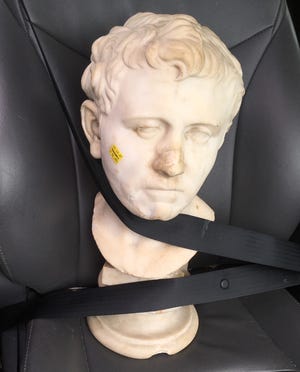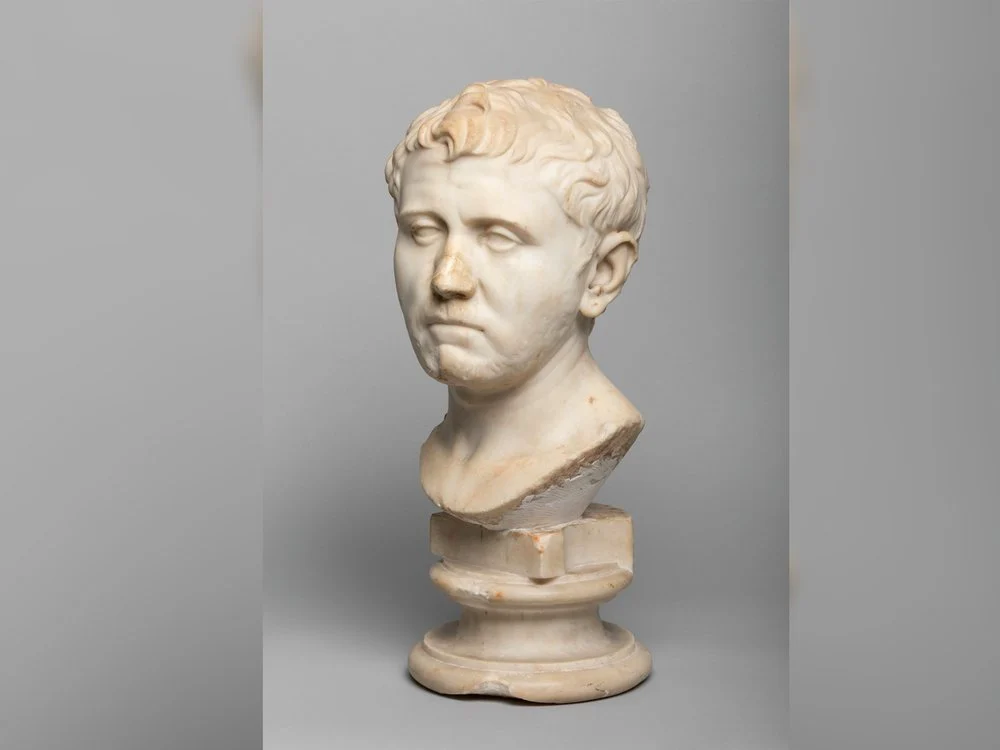When Laura Young first spotted “Dennis Reynolds,” a 52-pound marble bust she named after a character in the television series “It’s Always Sunny in Philadelphia,” in an Austin Goodwill, the sculpture had a $34.99 price tag slapped across its cheek. She strapped it in her car and took it home.
Four years and countless phone calls, emails and car rides later, Dennis – identified as a 2,000-year-old Roman relic – is now on display at the San Antonio Museum of Art, where it will remain on loan until 2023.
“I babysat this artifact for nearly four years. I’m so excited for other people to know about him and see him,” Young, an Austin antiques collector, told the Statesman on Friday, two days after she first broke her silence about the discovery and the yearslong journey to get it back to its rightful owner in Germany.
A woman bought a sculpture at Goodwill for $34.99.

When was the Roman bust sculpted?
Sculpted sometime between the late first century B.C. and early first century A.D, the bust was part of the collection of a German king and it made its way to a replica of a Roman villa-turned-museum in the German town of Aschaffenburg in the mid-1800s, according to SAMA. It was transferred to a storage facility just in time to miss the villa’s partial destruction in a bombing during World War II.
It’s not known how the bust got to Texas, and the last time it was heard of was in a 1950s note saying it was stolen, according to Lynley McAlpine, a postdoctoral curatorial fellow at SAMA..
“Then in the Fall of 2018, a flow of emails came in,” McAlpine said. “There was a flurry of excitement.”
A picture of the sculpture made its way to Jörg Deterling, a consultant at the New York City auction house Sotheby’s, who matched it to a bust in a 1931 picture of the German villa which used to house it. With a tentative identification, Young contacted UT Austin faculty members who connected her to McAlpine’s colleague and SAMA Curator Jessica Powers.
Within weeks, McAlpine and Powers traveled to Young’s house to see the masterpiece in person.
“Shockingly it’s in amazing condition,” said McAlpine, who compared the bust to the 1930s picture Deterling found. “There’s definitely some scratches and nicks in it that weren’t there then but overall [it’s] in good condition.”
Returning the Roman bust to Europe
Young knew she had to return the sculpture.
“It’s bittersweet. It would have been nice to keep him but I’m glad that I was the one who found him. I’m glad that he didn’t end up in someone’s backyard,” she said.
“There was a nerve wracking aspect to it, too,” she said. “At the end of the day I technically didn’t own him and there’s a question of liability. What happens if he falls? What if someone found out and took him?”
Although Young’s contract with German authorities prevents her from disclosing the value of the bust, Amineddoleh said Young could have sold the artwork for hundreds of thousands of dollars when she first purchased it. The media attention Young’s story has garnered likely shot the value up further.
“I can tell you that once an object comes into the spotlight like this, its value goes even higher,” she said.
‘It’s a big deal’
The COVID-19 pandemic caused long delays in relocating the bust. In April 2022, it finally made its way to the Gilbert M. Denman Jr. Gallery as one of the most ancient Roman artifacts in its midst.
“It was complicated and there was definitely some frustration with the delays. You can’t just FedEx a sculpture to Europe,” McAlpine said. “But there’s a happy ending.”
On Wednesday, Young was one of the first SAMA visitors to view the bust in its new home. She said she ran into the gallery screaming, “Where is he? Where is he?”
“It’s a big deal. It’s like my baby is graduating,” she said.
Tatiana Herrera-Schneider, a spokesperson at SAMA, said the bust brought welcome publicity to the museum and likely increased foot traffic in its halls.
“We are more of a stopgap in the process of getting it back to its rightful home,” she said. But “it’s exciting. Everybody wants to have that Goodwill find and It’s interesting to think that this work has come from this house in Germany all the way to Austin, Texas, in dialogue with our own collection.”

